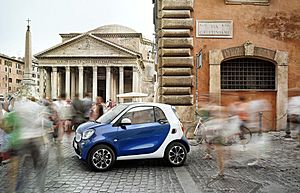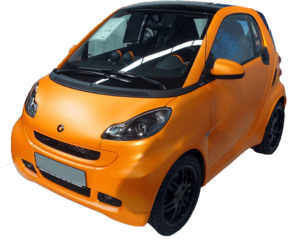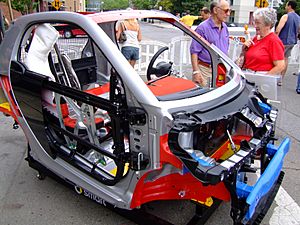Smart (marque) facts for kids
 |
|||||||
| Joint venture | |||||||
| Industry | Automotive | ||||||
| Founded |
|
||||||
| Headquarters |
,
China
|
||||||
|
Key people
|
Tong Xiangbei (CEO) | ||||||
| Products | Electric vehicles | ||||||
| Owners |
|
||||||
| Subsidiaries |
|
||||||
| Chinese name | |||||||
| Simplified Chinese | 智马达汽车有限公司 | ||||||
| Traditional Chinese | 智馬達汽車有限公司 | ||||||
|
|||||||
Smart is a car brand that started in Germany in 1994. It's known for making small cars. Today, Smart Automobile Co., Ltd. is a special partnership. It was formed in 2019 by Mercedes-Benz AG (a German car company) and Zhejiang Geely Holding Group (a Chinese car company). This partnership makes Smart cars in China and sells them all over the world. Their main office is in Ningbo, China.
Smart cars were first famous for being very small, like the Fortwo and Forfour. These cars were built in France and Slovenia. Since 2019, Smart has focused on making small battery electric vehicles (cars that run only on electricity). These new electric cars are made in China. A company called Smart Europe GmbH handles selling and marketing these cars in Europe. Its main office is in Stuttgart, Germany.
The Smart brand was created in 1994 by Micro Compact Car AG (MCC). This was a partnership between SMH (known for Swatch watches) and Daimler-Benz. Daimler-Benz later took full control of MCC in 1998. The name Smart comes from "Swatch Mercedes ART," showing its original partners.
Contents
Smart Cars: A Brief History
How Smart Cars Started
The idea for Smart cars began at Mercedes-Benz in the 1970s and 1980s. The first Smart car was released in October 1998. It was called the "City Coupé," but later became known as the "ForTwo."
In 1982, Nicolas Hayek, the CEO of SMH (the company that makes Swatch watches), had an idea. He wanted to create a small, stylish car for city driving, like a "Swatchmobile." He thought car companies weren't making cars for people who wanted something small and cool. Hayek's company started designing this two-seater car with a hybrid engine.
Hayek wanted to work with an existing car company. He first made a deal with Volkswagen in 1991. However, the new CEO of Volkswagen, Ferdinand Piëch, ended this project in 1993. Volkswagen wanted to focus on their own small, fuel-efficient car.
Hayek then talked to other car companies and finally made a deal with Daimler-Benz AG (the company that makes Mercedes-Benz cars) in 1994. They formed a new company called Micro Compact Car AG (MCC). SMH owned 49% of MCC, and Daimler-Benz owned 51%.
Building the First Smart Cars
MCC quickly chose Hambach, France, as the place to build the factory. This factory became known as "Smartville."
In 1995, the company decided to have different suppliers build parts of the car. This helped share the costs and responsibilities. Daimler-Benz increased its ownership in MCC to 81% by 1996.
The factory opened in October 1997. The first Smart City-Coupé was supposed to launch in March 1998. However, tests showed the car needed safety improvements. Engineers made changes to make the car more stable. The car finally launched successfully in October 1998 in nine European countries.
Soon after, Daimler-Benz bought out SMH's remaining share. MCC became fully owned by Daimler-Benz (which later became DaimlerChrysler). The company's name changed to MCC smart GmbH and then simply smart GmbH.
Growing and Changing (1998–2019)
Smart later added other models, like the Roadster (a sporty car) and the Forfour (a four-door car). The original City-Coupé was renamed Fortwo.
However, Smart GmbH lost a lot of money from 2003 to 2006. Because of this, Daimler decided to stop making the Forfour and the Roadster. In 2006, Smart GmbH became part of DaimlerChrysler (later Daimler AG). Until 2019, Smart was a brand within the Mercedes-Benz Cars division.
The Geely Partnership (2019–Present)
In 2019, Daimler announced a new partnership with the Chinese carmaker Geely. This deal was worth about $830 million USD. It involved building a new factory in China to make a new generation of Smart cars.
In 2021, the first concept car from this partnership was shown. It was called Concept #1. This electric concept car was built on Geely's special car platform. It had design features like a glass roof and large touchscreens inside.
Smart Car Models
Besides the original Smart Fortwo, Smart also offered the sporty Smart Roadster, a special edition Smart Crossblade, and the supermini Smart Forfour. These models are no longer made.
Current Smart Models
| Production | Model | Picture |
| 2022–present | Smart #1 |  |
| 2023–present | Smart #3 |  |
| 2024–present | Smart #5 |  |
Past Smart Models
Concept Vehicles
Concept cars are special models that show new ideas and designs.
- Tridion 4 (2001)
- Crosstown (2005)
- Formore (2005)
- Forspeed (2011)
- Forvision (2011)
- For-Us (2012)
- Forstars (2012)
- Fourjoy (2013)
- Concept #1 (2021)
- Concept #5 (2024)
Smart Cars Around the World
Asia
Japan
In Japan, some early Smart models were small enough to be called "Kei cars." This meant they had lower taxes. Newer Smart models are larger and don't fit this category.
China
Smart cars were first shown in China at the Beijing Auto Show in April 2008. Pre-sales for the Smart Fortwo began in October 2008. Smart cars are also available in Hong Kong.
Indonesia
The Smart Fortwo has been available in Indonesia since November 2010. It was sold in cities like Jakarta and Bali. Indonesia was also the first country in Southeast Asia to have the Smart Electric Drive for a trial period. Smart is planning to return to Indonesia in 2024, bringing the Smart #3 Premium and Brabus models.
North America
Canada
The Smart Fortwo came to Canada in late 2004. It was sold through Mercedes-Benz dealers. Many people wanted the car, especially commuters. Sales were strong in Western Canada, particularly in Vancouver.
Daimler announced in April 2019 that 2019 would be the last year for Smart sales in Canada. However, they continue to support existing Smart car owners.
United States
Before 2008, Smart cars were not officially sold in the United States. People had to import them through special companies.
In June 2006, DaimlerChrysler announced that Smart cars would officially launch in the U.S. in early 2008. They were sold through a new dealership network called Smart USA. The updated gasoline-powered Fortwo was the first model offered.
The Smart Fortwo got a lot of attention in the U.S. It was seen as a very small car in a country known for large vehicles.
In 2011, Mercedes-Benz USA took over selling and marketing the Smart brand from Penske Automotive Group.
In February 2017, Smart USA announced that it would stop selling gasoline models after the 2017 model year. The brand decided to focus only on electric cars for the U.S. market starting in 2018.
Smart left the U.S. market after the 2019 model year. This was due to slow sales and the high costs of making the Fortwo meet U.S. car rules.
Mexico
Smart offers the hardtop and convertible versions of the Fortwo coupé in Mexico. The Smart Fortwo was introduced in 2003. It was first sold in department stores and later by Mercedes-Benz dealers.
South America
Argentina
In Argentina, the Fortwo has been sold since 2010. You can buy Fortwo Cabrio and Fortwo Coupé models in dealerships in Buenos Aires.
Brazil
In Brazil, the Fortwo has been sold since 2009. It was available in cities like São Paulo and Rio de Janeiro. Smart stopped selling cars in Brazil in 2016. However, Smart is planning to return to Brazil by 2026 with electric cars.
Oceania
Australia
Smart cars were sold in Australia from 2003 to 2015. The brand left Australia in March 2015 because of low sales. However, it was announced in May 2024 that the Smart brand would return to the Australian market.
Europe
In 2004, Smart cars were launched in countries like Canada, Malaysia, Malta, Norway, and Romania.
United Kingdom
Smart cars launched in the United Kingdom in 2000. The current models available are the Smart Fortwo convertible and the Smart Fortwo Coupé. You can buy Smart cars through Mercedes-Benz dealers in the UK.
Russia
The Smart brand started selling cars in Russia in 2012, offering only the Fortwo model.
Smart Car Safety
The Smart Fortwo has a very small front crumple zone. This is the part of the car designed to crumple and absorb energy in a crash. The second-generation Smart Fortwo received 4 out of 5 stars for adult safety in Euro NCAP tests. It also got "Good" ratings in front and side crash tests by the Insurance Institute for Highway Safety (IIHS) in the U.S.
However, in a specific crash test in April 2009, where a Fortwo crashed into a Mercedes C-Class, the Smart car showed significant damage. The IIHS rated the Smart Fortwo "Poor" in this specific test, noting that a driver could get serious injuries.
The main part of the Smart car is a very strong frame called the Tridion Safety Cell. This frame is designed to protect the people inside the car during a crash. It works by making the other car's crumple zones absorb the impact.
Images for kids
-
Former Smart offices in Böblingen
See also
 In Spanish: Smart para niños
In Spanish: Smart para niños





















